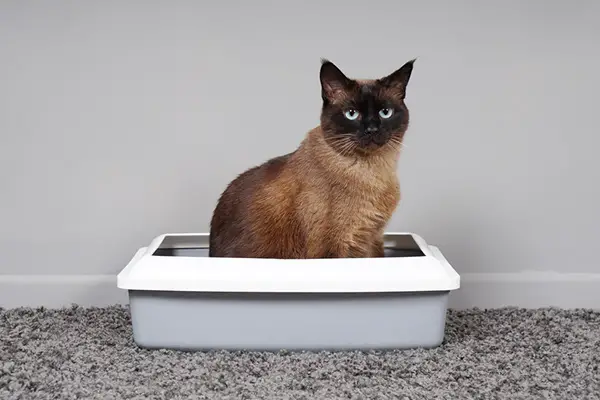When you’re introducing a new cat in your home, it’s important to train her to use the litter box first. However, this is not something that you should be worried about. Litter training cats is not as hard as house training dogs. This is because cats already have an instinct on pooping or peeing in one location only – the litter box. Here are some ways on how to effectively litter train your new kitten or retrain your adult cat.

Factors to Consider that might Affect your Litter Training
Make sure you have the right litter box
Choosing the right litter box will make litter training easier. This is because there will be less of a chance that your cat refuses to use its litter box. Here are the things you need to consider to choose the right litter box.
Litter Box Size
Whether your litter training a kitten or retraining an adult cat, always take consideration of the litter box’s size. Your litter box must be large enough for your cat to fit in. Make sure that it has a generous space that allows your cat to move around to cover his waste.
If the litter box is too small, there is a big possibility that your cat will feel cramped, and eventually, she will end up not using the box. When this happens, she’ll likely move to a different location to do her business. This will be a bigger problem on your part.
Covered or Uncovered
Litter boxes come in two types: enclosed or open. Try to weigh in the pros and cons of each before deciding which type you prefer.
Enclosed or hooded litter boxes offer excellent privacy. This is the most significant advantage they have, especially for cats who like having some peace while they do their business. It also prevents your cats from making a lot of mess after using it. Just make sure that there’s a generous space inside that will allow your cat to move around.
Open litter boxes, on the other hand, don’t provide privacy. However, it’s an excellent option for litter training kittens. This is because you’ll find it easier to observe their behavior while they’re using the litter box. If there are changes needed, it’s easier to correct.
It’s best to take note that your cat might have her own preference. If possible, try both boxes and see which type your cat prefers better.
Choosing the Right Cat Litter
The quality of the cat litter is also essential. This will influence your cat’s decision to keep on using the litter box. If you’re taking in a new cat from an adoption home, then the best choice would be the previous cat litter. However, if it’s a stray cat, then it might take a few trial and error.
Generally, cats prefer clumping litter as it has a softer feel. This means it’s comfortable to walk on, and it’s easier for your cat to bury her waste. It also gives excellent convenience on your part as it will be easier to scoop and clean the litter box.
Litter Box Location
The location of the litter box is crucial. You should make sure that it’s in a place that offers excellent privacy and accessibility.
Just like us humans, our feline friends would like to find the toilet immediately when they want to pee or poop. So, make sure that the location of the litter box is accessible and convenient for them. If they’re unable to access it quickly, she might look for an alternative place to do his business.
Another thing you can take note of is to place the litter box in a location that offers excellent privacy. This can be in the corner of a room that you don’t frequently use. In other words, the lesser the traffic the better. This will also prevent your cat from getting startled while she’s in the middle of using the toilet.
Finally, don’t change the location of the litter box if your cat has no problems using it. This is to avoid any confusion.
How to Litter Train a Kitten Fast
Here are the essential things you need for training a kitten: litter box, kitty litter, and treats and toys.
When your new kitten first arrives at your home, introduce her to the litter box immediately. Set her in the litter box and let her sniff and examine it so she can quickly get the idea that that is her toilet area.
The following days, make sure you set your kitty into the box every after meals and after she wakes up from her naps. If you notice any behavior where it seems she needs to use the litter box, don’t hesitate to pick her up and place her inside.
Continue doing this until she learns to use the litter box on her own (this won’t take too long). When she does, don’t forget to reward her for doing a great job. Give her some treats or a toy to encourage her to keep on doing this.
Finally, don’t scold her if she accidentally poops outside the litter box. Doing so will cause stress and anxiety, which can make litter training more difficult.
How to Litter Train an Older Cat
Cats have instincts when it comes to using litter boxes. However, when it comes to adopting an older stray cat, getting them to get used to the litter is the biggest challenge. To conquer this, I recommend using outdoor soil first. Then, gradually change it with the cat litter you’re using until she gets familiar with the new texture or surface.
There are also cases when your cat suddenly doesn’t use their litter box and poops outside the litter box. This might have made you think, “Why is my cat pooping outside the box?”
Well, when this happens, the number one culprit is stress. So, take your cat to the vet and have her checked for any medical conditions.
If she doesn’t have any problems with her health, then you might need to think about what changed in his environment. Also, consider changing the litter box if you think it’s too small for your cat. You can change up the location as well. In other words, try to change a few things that you think is the culprit to this issue.
Once changes are applied, your cat might not have any problems with using their litter box anymore.
Wrapping it Up!
If there’s one thing to love about cats, is that they’re naturally clean and tidy. They have instincts of using one location as a toilet, and this helps a lot in litter training them.
Just make sure that you also maintain the cleanliness of the litter box always. Scoop clumps of litter daily, at least twice in a day. Do some deep cleaning as well, so you can assure that bad odor wouldn’t accumulate from the inside of the litter box.
Don’t think about litter training as something complicated. Remember these tips and follow them accordingly. Surely, you’ll find litter training a breeze.
The post How To Train A Cat To Poop In A Litter Box appeared first on Furry Friends Gear.

No comments:
Post a Comment